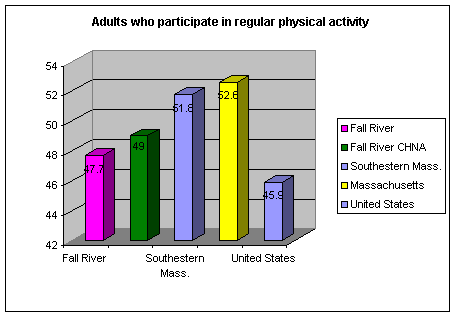 |
|
|
|
HOME | ABOUT US | WORKGROUPS | YOUTH | RESOURCES | MINUTES | NEWSLETTER | CALENDAR | LINKS |
||
 |
|
|
|
HOME | ABOUT US | WORKGROUPS | YOUTH | RESOURCES | MINUTES | NEWSLETTER | CALENDAR | LINKS |
||
|
Information on the prevalence of risk factors and
behaviors that contribute to leading causes of death helps in identifying
and prioritizing areas of greatest need for health intervention and in
planning effective health promotion and disease prevention programs.
An excellent source of data is the Behavioral Risk Factor Surveillance System (BRFSS), an ongoing, random-digit dial statewide telephone survey of adult residents age 18 and older. The BRFSS is currently conducted in all states as a cooperative effort between the national Centers for Disease Control and Prevention and state health departments. The BRFSS includes questions about a wide variety of health issues, from personal behaviors and access to medical care to opinions on health-related policy issues. The Massachusetts Department of Public Health (DPH) provides a special report that summarizes results of the BRFSS for the Partners for a Healthier Community, Greater Fall River CHNA for the years 2000 through 2005. To see a complete copy of the report at click here or contact Partners at drweed@cox.net to request a printed copy. Additional statistics for the Fall River area can be found in
Current health information for the Fall River area can also be obtained through use of MassCHIP.
| |||
|
| *Click here to obtain Acrobat Reader to read PDF documents | ||
|
| |||
|
Health Risks and Preventive Behaviors Results from the Regional Health Status Indicators Report, June 2007
| |||
| Tobacco use causes more deaths in the U.S. than any other preventable risk factor. Smoking causes lung cancer as well as laryngeal, oral, esophageal, bladder, pancreatic, kidney, and cervical cancers. Lung cancer mortality rates are about 22 times higher for current male smokers and about 10-12 times higher for current female smokers compared to lifelong never smokers. In the Partners for a Healthier Community, Greater Fall River CHNA, 27.1% of adults were current smokers (see chart at right). The percentage of current smokers was significantly higher than the state average and well above the national figure.. |
| ||
| Obesity is defined as a body mass index (BMI) of 30 or greater. Increasing BMI is positively correlated with higher blood cholesterol levels. In addition, obese individuals are at increased risk of developing diabetes, hypertension, heart disease, gall bladder disease, and osteoarthritis. The proportion of adults in the U.S. population who are obese has been increasing over time, a trend that is mirrored in Massachusetts. In the Partners for a Healthier Community, Greater Fall River CHNA, 31.7% of adults were obese, based on self-reported height and weight measurements. |
 | ||
| Regular physical activity has been demonstrated to have protective effects for several chronic diseases, including coronary heart disease, hypertension, non-insulin-dependent diabetes mellitus, osteoporosis, and colon cancer. Regular physical activity also reduces feelings of depression and anxiety, is an essential component of weight loss programs, and may be linked to reduced risk of back injury. Additional benefits of regular physical activity include helping older adults maintain functional independence and enhancing the quality of life for people of all ages. In the Partners for a Healthier Community, Greater Fall River CHNA, 49% of adults participated in any regular physical activity in the past month, significantly lower than the state average. |
 | ||
| Fruits and vegetables supply a variety of nutrients, and many studies show that the consumption of fruits and vegetables (especially dark green, leafy vegetables) protects against cancer, particularly cancers of the gastrointestinal and respiratory tracts. In addition, eating fruits and vegetables as part of a diet that is low in fat, saturated fat and cholesterol, and high in fiber can decrease the risk of heart disease. The National Cancer Institute, American Cancer Society, and American Heart Association recommend that individuals consume at least 5 servings of fruits and vegetables daily. In the Partners for a Healthier Community, Greater Fall River CHNA, 22.7% of adults consumed at least 5 servings of fruits and vegetables per day. The percentage of adults who consumed at least 5 servings of fruits and vegetables per day, while lower, was not statistically different from the state average. |

| ||
| Return to the Partners Home Page | |||